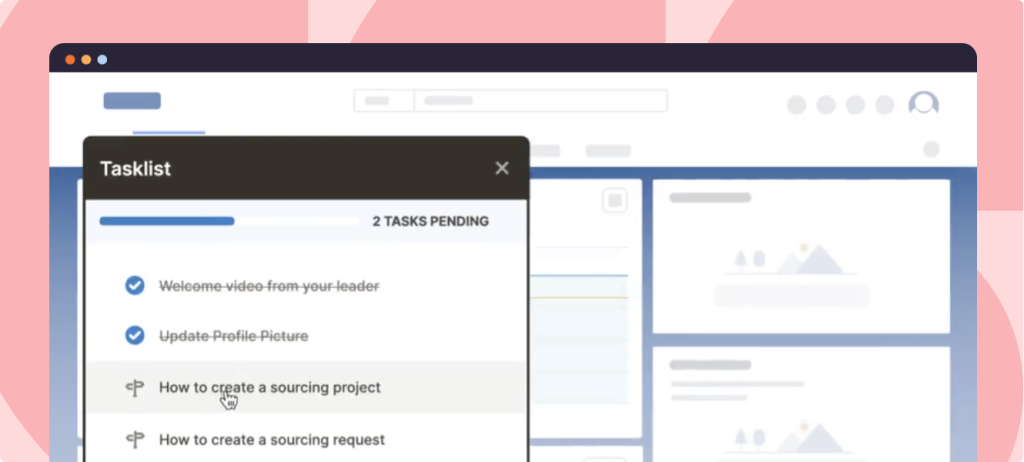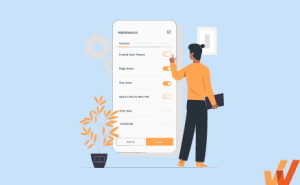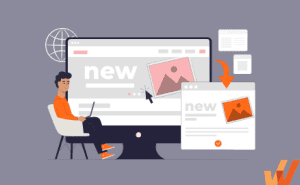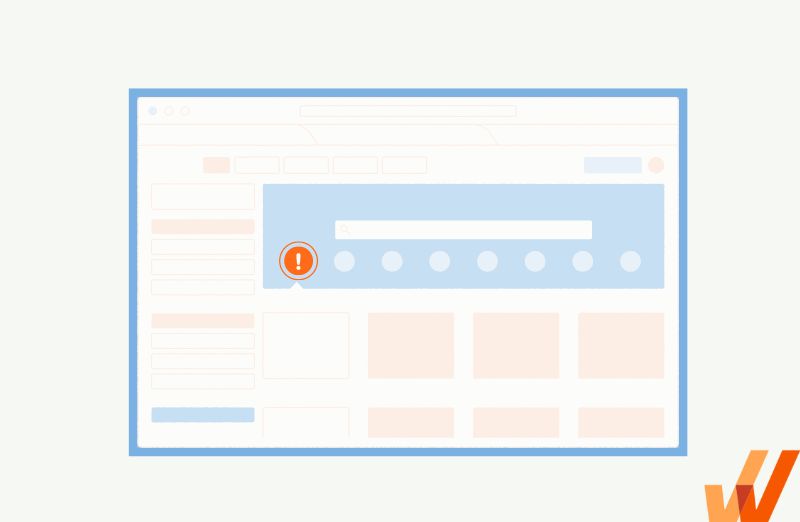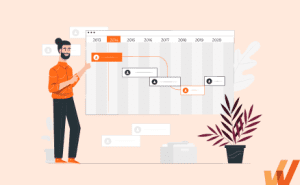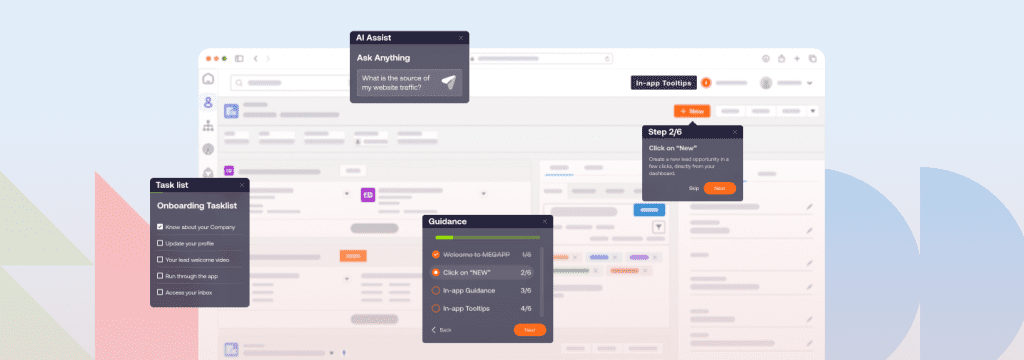Over 30% of IT professionals say their SaaS spend is underutilized or wasted.
A large indicator of underutilized business software is when platform features aren’t used how they should be. A lack of product training is one factor, but another contributing issue is the poor communication vendors have when it comes to informing users about new features and product updates.
Feature discovery strategies are becoming increasingly essential in a competitive digital landscape where one feature is enough to cause companies to migrate to an entirely different system. It’s a critical step to empowering customers with the tools to find new features that are rolled out, to drive overall product adoption, and for SaaS companies to retain and upsell.
In this article, we explore what feature discovery is and how you can deploy content that surfaces essential aspects of a platform for higher adoption levels.
What Is Feature Discovery?
Feature discovery describes showcasing a product’s new or updated capabilities to existing users. Think about the last product update made to one of the apps in your technology stack. How did you find out about it?
Some users learn about new features and updates through a company’s marketing and communication channels, like new feature launch email announcements, blogs, social media posts, and change logs. But this alone isn’t enough to show users what your features look like in action and educate them about their benefits.

Above: An example of Buffer using its Instagram page to drive awareness of its new Start Page feature.
Your users will have the most success using new features if they can see it clearly within your product and can access content educating them about the adoption process. Feature discovery helps teams capture users’ attention and retain their interest through strategic additions to the product, like UX changes, updated product copy, pop-ups, beacons, and guided product walkthroughs.
Feature Discovery vs. Feature Adoption
Feature adoption occurs when users regularly use product features to complete tasks. Feature adoption rates are a more common metric for measuring and comparing user journeys throughout a product. Adoption can be achieved if feature discovery tactics are prioritized and strategically placed at specific locations in the product.
Feature discovery is the first step toward feature adoption. Your users can’t adopt a feature that they don’t know about. Without the discovery phase, it’s impossible for you to even begin training your users on how to integrate new features into their day-to-day workflows.
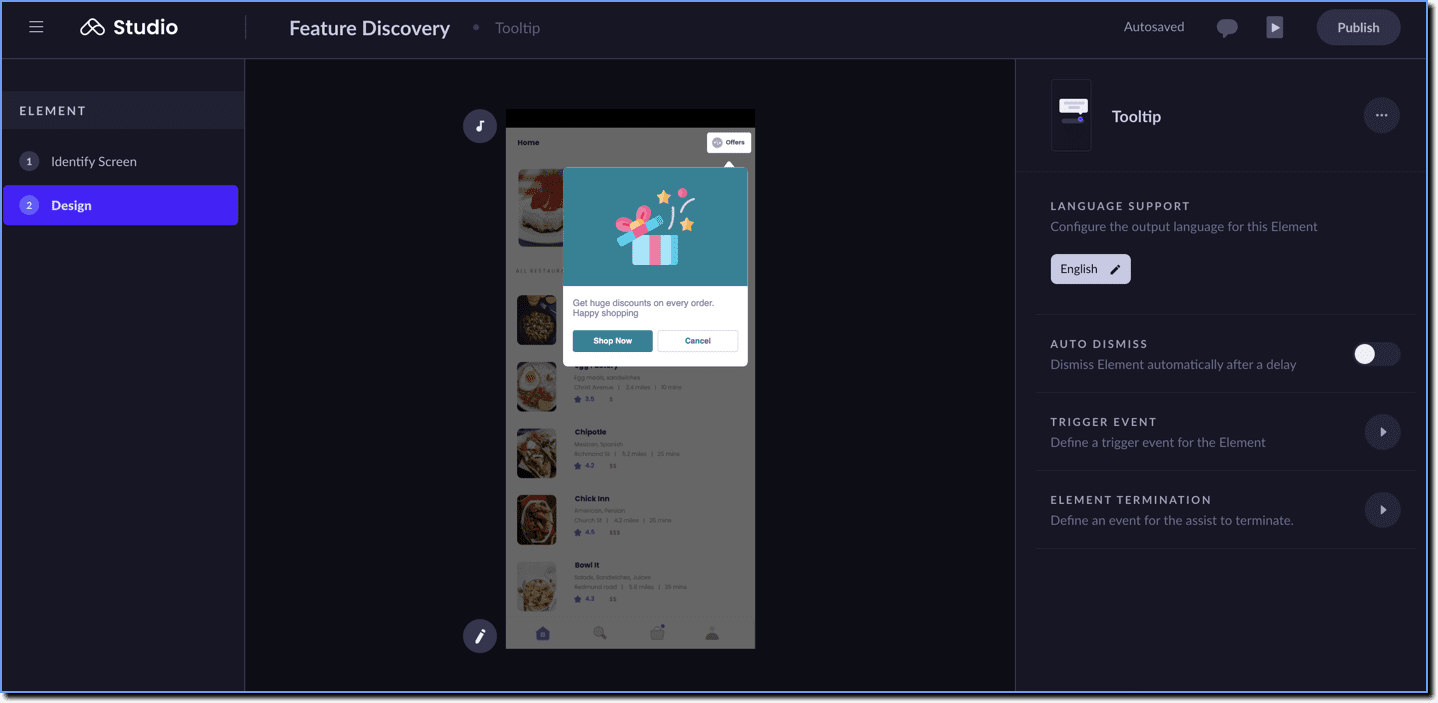
Above: How to create in-app hotspots, pop-ups, and tooltips in Whatfix’s mobile editor to drive feature awareness and adoption.
That said, feature discovery and adoption go hand in hand. To increase adoption rates for specific features, you must invest in digital experiences that allow users to stay engaged and productive even as a product evolves.
The Importance of Feature Discovery
We talked about how feature discovery enables higher adoption rates, but how exactly does it contribute to motivating users?
When 451 Research wanted to increase feature usage in their research publishing and digestion platform, they narrowed down on the user experience of navigating an information-heavy platform.
Although they had a feature that allowed customers to self-search for information, it was difficult for customers to make the most of that capability without the help of the customer support team — which also took away the point of being a self-service platform.
451 Research overcame the problem by optimizing its user journey to focus on feature discovery and customer education. With in-app guidance and interactive product walkthroughs, customers could locate specific features without external innovation. They could also find the right support resources quicker to accelerate their proficiency using the feature.
From this example, we can see how feature discovery provides the following benefits:
- Builds confidence in the platform: Users find a tool more reliable and convenient to use if all updates and changes can be implemented without external friction and dependencies
- Drives engagement with users: Users can explore and experiment with new platform capabilities and related content at their own pace, making the learning curve for a product more exciting and enjoyable
- Increase user satisfaction: The less time spent figuring out how to use a product, the more time your users can spend maximizing features to make their jobs easier.
- Lower customer support costs: Self-service feature discovery frees up your team from spending customer support resources on smaller issues that can easily be automated using digital adoption platforms
Challenges of Feature Discovery
When Apple announces new features for the iPhone, it feels as though the whole world is listening and waiting intently.
Even with 14 versions of the iPhone, Apple still manages to get customers excited about a new Action Mode made available in the Camera app and a 2x zoom lens on the iPhone 14 Pro.
Getting these levels of excitement is difficult, especially in feature-rich business systems. Feature discovery has to always be at play, long after the excitement of buying a new software has worn off.
Here are four challenges to think about as you implement your feature discovery tactics:
1. Promoting multiple features
When multiple features are released at the same time, customers can find it confusing and overwhelming familiarizing themselves with it all. Interactive walkthroughs and strategically placing pop-ups can help you show customers how to best prioritize and approach new features for performing specific tasks.

2. Measuring and tracking feature discovery
Investments in feature discovery can be hard to push for without tangible results about its impact on product adoption. Digital adoption platforms (DAPs) like Whatfix help teams surface metrics that quantify the ROI of feature adoption, like feature engagement and drop-off rates or the number of interactions made with feature-specific content.
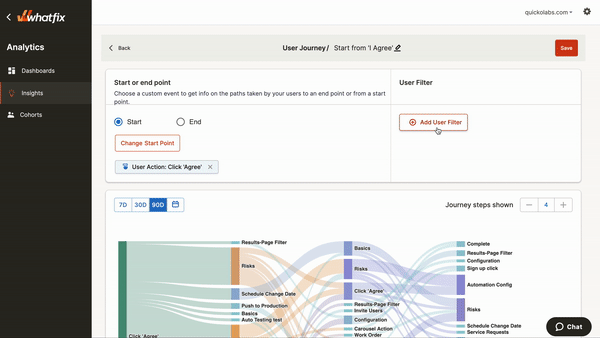
3. Driving discovery of new features post-onboarding
Users may be less engaged and consistent with a product after onboarding because they believe they’ve already learned what they need to know about the platform. Prominent interactive content like beacons, hotspots, and tooltips have to be surfaced in-app to continue driving attention toward new features as soon as existing users log in.

4. Contextual feature messaging for how different user roles or types can utilize the feature
The same platform is often used in different ways depending on users’ roles and responsibilities. Surfacing irrelevant or too generic information can lead certain users to assume that the new features were not built to help their use case. This is why companies use DAPs to personalize a product’s user experience and support content based on user segments who interact with new features.
How to Promote Feature Discovery With Your Users
It’s easy to miss out on features in software tools and platforms because there are so many capabilities that users can interact with when they log in. Your feature discovery strategies should be visible within the product and easily accessible throughout UX flows and user journeys.
You can also drill down on essential pages, screens, and call-to-actions to surface feature-related content when most relevant to users.
Here are four actionable ways you can implement feature discovery for your users:
1. Incorporate feature walkthroughs in your user onboarding
Your users have a lot to learn and familiarize themselves with as they are onboarded onto a new tool. If a platform is feature-rich, you can create opportunities for users to view interactive demos of core features during product onboarding. For example, you can point users toward a walkthrough during an initial interaction with a feature — like the first time they land on a particular page, click a button, or complete an action.
Whether you take a build or buy approach to your user onboarding solution, make sure to include feature walkthroughs.

2. Use in-app hotspots, pop-ups, and other alerts for new or undiscovered features
Not all your features will be visible on homescreen or navigation bar. Even if they are, users might miss them if they’re so accustomed to performing a specific set of actions within a tool. Hotspots, pop-ups, and alerts help you catch your audience’s attention and hook them with a value proposition about new and underutilized features.
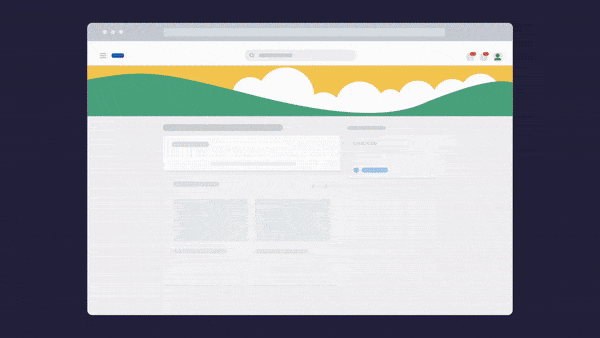
![]()
3. Publish and promote release notes and change logs for end-users
Even if your users see alerts and pop-ups, they may not recall the exact information that was surfaced or what to do next — especially if they were on the go or in the middle of another task. Release notes and change logs give users a centralized location to quickly review and stay informed of all changes happening within your product. It also makes it easier for information on feature updates to be shared from one user to another in the same team.
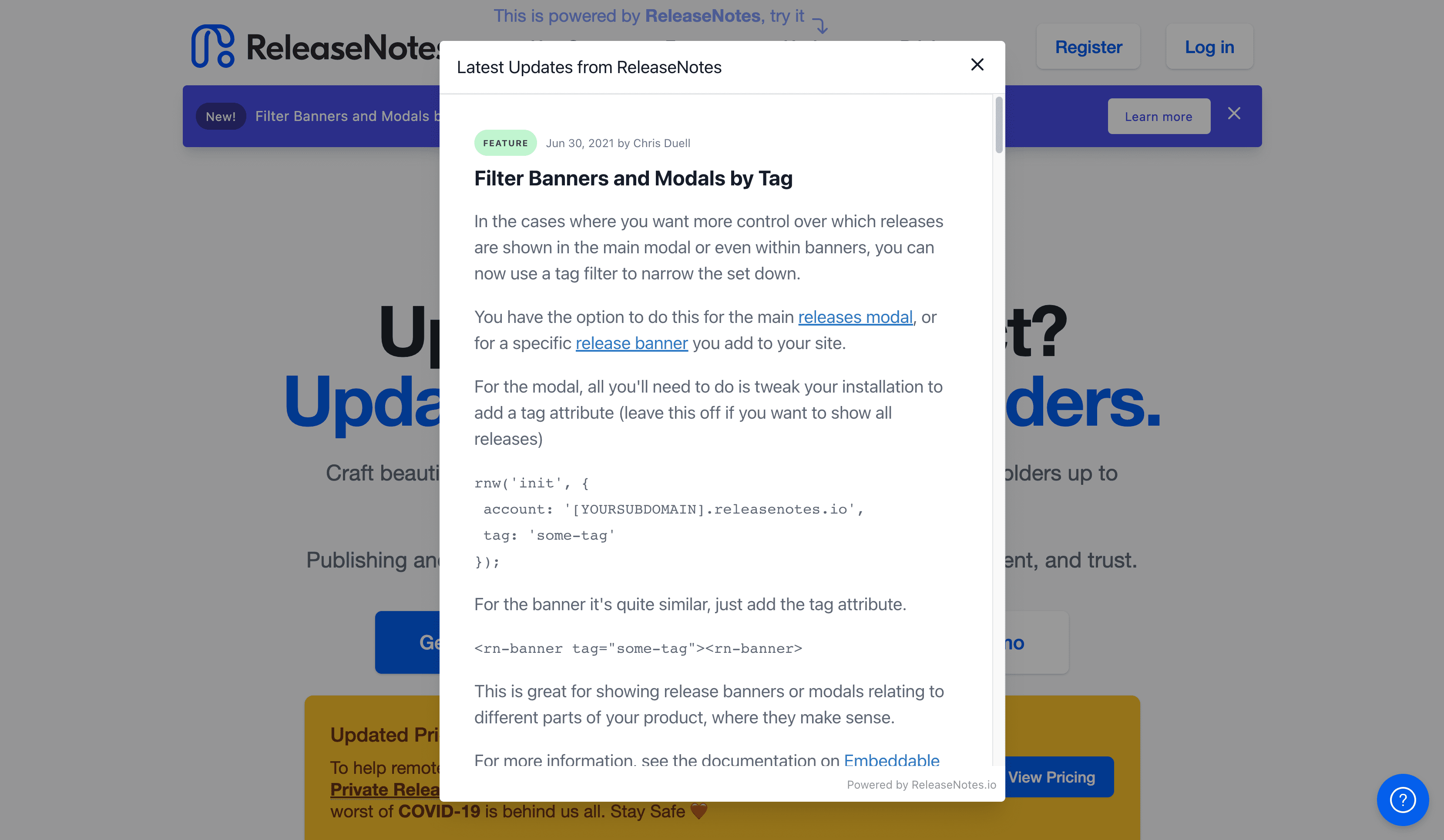
4. Track feature discovery with a product analytics and adoption tool
The impact of your feature adoption tactics can be easily overlooked unless you have a way to capture data and visualize it for stakeholders. Product analytics tools like Whatfix automates the creation and deployment of feature discovery content. But better yet, it automatically tracks how users interact with content so you can measure engagement and spot opportunities for personalized journeys, optimized copy, and more self-service support.
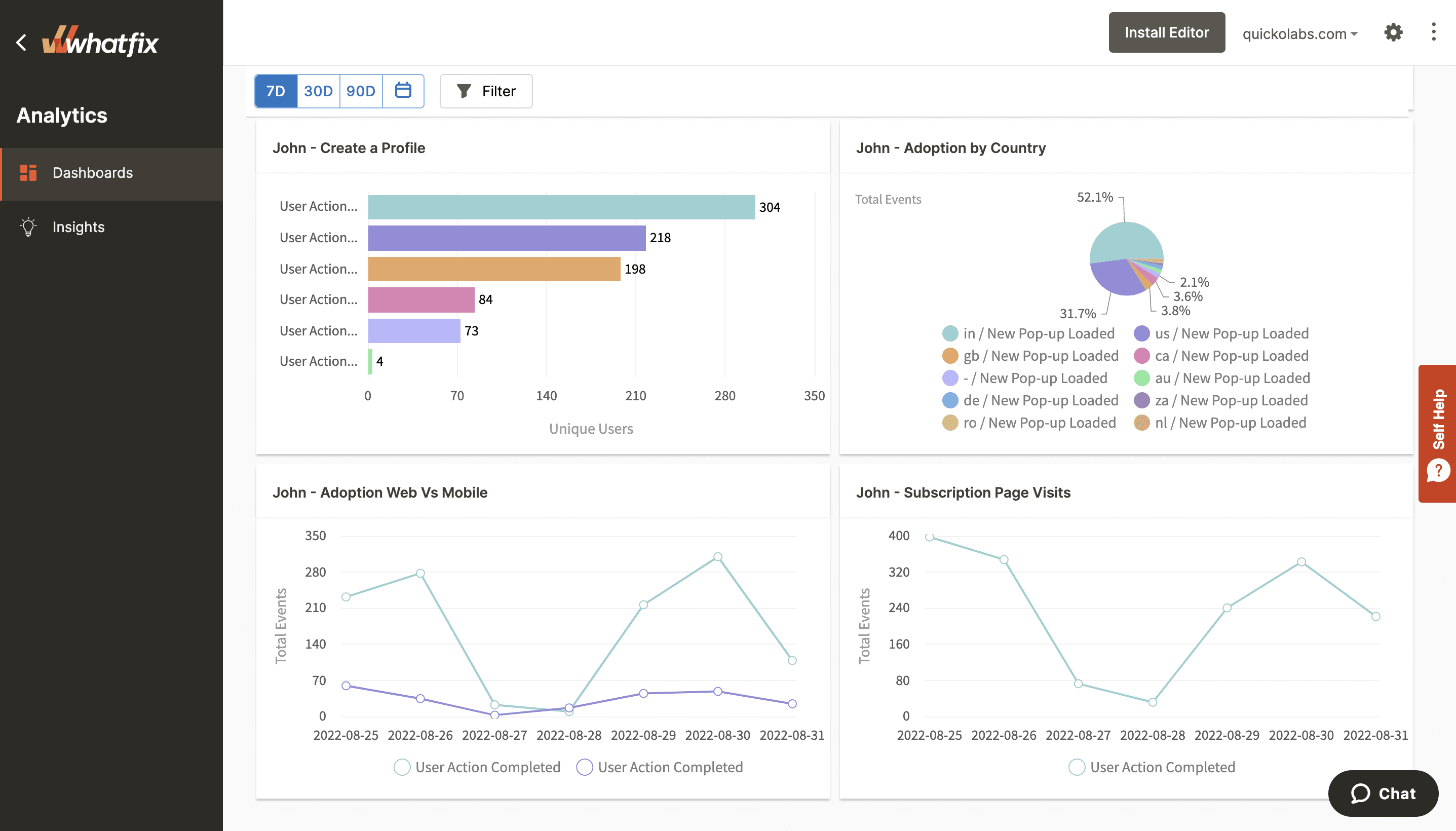
4 Examples of Feature Discovery
We’ve talked about what makes a good feature discovery strategy. But what does that look like in action?
Let’s dive into a few examples of apps and products that do a great job at communicating feature launches and updates to their users.
1. Loom’s in-app pop-up and feature walkthrough for “Spaces”

How does this pop-up help users?
- It draws users’ attention right within Loom’s homepage to surface quick and concise copy about what Spaces is and who it benefits.
- Users are brought to another pop-up showing them where they can access Spaces within the homepage, which removes the need for them to locate it themselves.
- By clicking on the pop-up, users see a window that prompts them to create a new Space of their own. Not only does this pique their interest, it encourages them to learn by doing.
2. G2’s new feature tool tip for its new MyG2 notification center

How does this tooltip help users?
- This in-app notification quickly informs users about new features in a less obtrusive way, which is useful for smaller feature launches and product updates.
- The tool tip points toward a location within the app that users can click on immediately to see the feature in action.
- Users must click on a button to acknowledge the tool tip and remove it from the screen, which motivates them to read the content within the text box.
3. Ahrefs “new” tooltip on newly-launched features

How does this tooltip help users?
- This is a perfect example of how to not confuse users about multiple new feature launches in a feature-rich system. Ahrefs calls out new features with a tooltip labeled “New” so users are aware where they need to go when they get the chance to explore these features.
4. Chorus overlays its release notes inside its SaaS app

How does this in-app content help users?
- Chorus can share more information about new features right within the app and remind them to check out the release notes if they want to learn more.
- A link to the new feature can be embedded directly within the content so users can engage with it immediately if they feel ready.
- Users can click on the overlay button at any point in the product journey to read about new features as long as that content is made available. Chorus can also use the overlay to surface related end-user support content or help users quickly search through a knowledge base.
Analyze, build, and deliver better product experiences with Whatfix’s in-app guidance, adoption, and analytics platform
If you’re looking to drive user retention and satisfaction by encouraging the adoption of exciting new features, Whatfix’s digital adoption platform can help streamline and automate content creation, implementation, and tracking.
With Whatfix, you can customize and deploy in-app pop-ups, tool-tips, contextual product walkthroughs, and more, in a no-code environment. Surface new and underutilized features to your users and gather their feedback in real-time with interactive widgets and tailored messaging that adds to their user experiences.
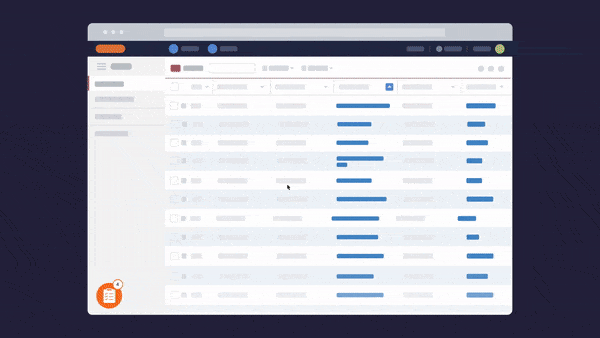
Whatfix’s built-in analytics capabilities lets you track and measure user engagement every step of the way so you can continuously identify areas for improvement.
To learn more about Whatfix for feature discovery, get a demo today.
